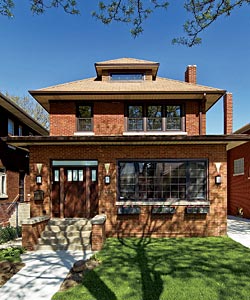
Adrienne Brown in the new kitchen, where counter space went from four feet to more than 20 feet with the addition of a large peninsula. "The Browns love to entertain; now they have room to do that," says Sacco. An inset coffee-making system allows for extra workspace, and the supporting white oak cabinets hold barware and cocktail supplies.
Photo Gallery »
Adrienne and Walter Brown recognized the potential in the handsome South Shore house they purchased in 1987, and as design aficionados, they were excited about the challenge of remodeling it to their liking. Built in 1918, "it looked good on the outside," says Adrienne, "but it was absolutely falling apart on the inside."
Things went well at first as the couple took on such surface projects as stripping nine layers of wallpaper from the walls, but when it came to issues such as construction and plumbing that needed outside help, the job turned into a nightmare. Frustrated by subpar work and shady contractors, the Browns halted all work and put their plans for improvement on hold.
Enter, early last year, interior designer Joseph Sacco, whose partner, Victor, is the Browns’ son. Sacco saw that with this house, he would have his work cut out for him. "Anything that was touched—I won’t even say updated—was done in the shoddiest way possible, put together with a lick and a promise," he says. The Browns had seen Sacco’s work and trusted him, so a new overhaul began.
"The only things I saved were the four brick walls, four pieces of artwork, some joists, and the roof," he says. "Everything else—every stick of furniture—is new." The Browns moved into an apartment for the nine months it would take for their extreme home makeover. The infrastructure was dealt with first: running new electrical and plumbing lines, installing central air conditioning, replacing radiators with a forced-air heating system, adding insulation, and tearing out three large backyard trees with roots that were breaking into the basement and into pipes, causing water problems. New sidewalks were laid, a large back deck added, and the landscaping reconfigured.
Because the house had such classic bones, Sacco knew just how far he could push a modernist interior, even though the Browns were open to drastic change. "They love contemporary design and wanted to make it really modern," he says, "but at the end of the day it’s a bungalow in a residential neighborhood, and I don’t think that would go over well for resale. I’d call what we came up with "transitional decor with a modern flair’—not modern modern."
The old floor plan of the house went against every impulse in Sacco’s design philosophy. "There were so many little rooms, with lots of unusable space, and it was dark," he says. "We took out walls—now you can walk in the front door and see all the way through to the back of the house."
Opening up the space left a lot of holes in the hardwood floors, so the original boards were removed, refinished, and pieced together to make the flooring upstairs; new flooring was created and stained to match for the ground floor. With an eye on further minimizing his carbon footprint and the budget, Sacco reused as much building material as he could, including brick walls that were shifted to create a better flow.
"I love the whole house," says Adrienne, "but what’s really nice is the new layout upstairs. My husband and I now have separate walk-in closets with track lighting, I’ve got a little seating area and an office where I can take care of my charity work, and the master bathroom is the bomb!"
For this explosive and expansive bath, Sacco reduced the size of an inexplicably large hallway and installed a pocket door to maximize space. "I go to so many homes and see these stupid bathroom doors that hit either the vanity or the shower," he says. "Why not do sliding doors? It’s plenty private, and 95 percent of the time it’s open, anyway."
Italian porcelain tile that resembles travertine (but is much easier to maintain) lines walls, floor, and even the ceiling above the rain shower—a protective strategy that will repel condensation. The standard 12-by-24-inch tiles were cut and arranged in a subtle mosaic pattern, for added interest. And a dramatic Kohler ceiling-mounted spigot was installed to fill the sleek Neptune Zen tub. "I’m not a boastful person, but when I show off my house and guests wonder how to fill that bathtub, I just tell them to please stand back," Adrienne says with a smile. "Joe took us to projects he’s done, and showrooms, and I saw things I didn’t even know existed."
Sacco also socked it to the cramped old kitchen, which sorely lacked counter space and storage. The owners used to have to go down to the basement for cooking supplies, so a powder room was sacrificed to make room for a pantry. White oak cabinets line one wall and also pull double duty as storage and support for a granite-clad peninsula that contains a sink, dishwasher, and drawers for trash and recycling bins. A wall-sunk Miele coffee-making system allows for even more workspace. Over the peninsula, three glass pendant lamps illuminate the room, which now flows openly into the dining area and a sunny seating nook overlooking the newly landscaped backyard.
"The old addition at the back of the house was on a lower level, and was freezing in the winter," Sacco says. "We lifted the floor up and raised the ceiling, removed French doors, replaced some tiny windows, and just rebuilt it completely." Now it’s a favorite spot for Adrienne to sit with a cup of tea and visit with her sisters, or simply to meditate and look out at the stars.
For resource information, see Buyer’s Guide.
Photography: Bob Cascarelli
Related:



